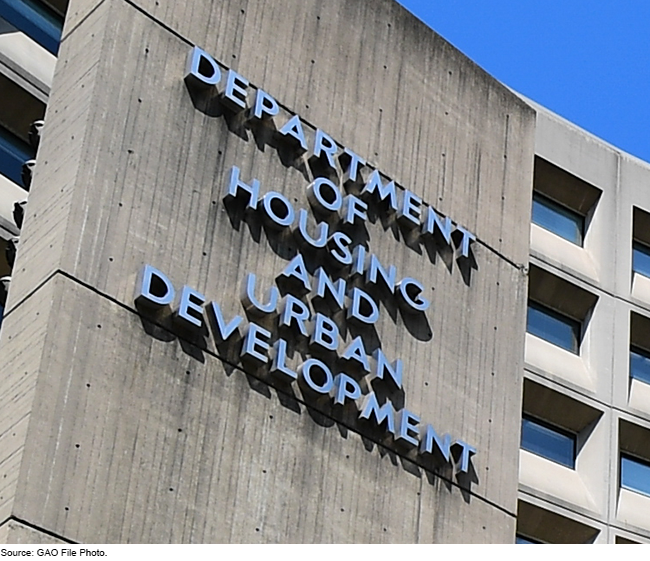Disaster Recovery: Better Data Are Needed to Ensure Equitable Delivery of HUD Block Grant Funds to Vulnerable Populations
Fast Facts
Since 1993, Congress has provided over $90 billion in Community Development Block Grant Disaster Recovery funds to help in the aftermath of natural disasters. We testified about how the Department of Housing and Urban Development has used these funds to assist vulnerable populations, including people with low and moderate incomes, the elderly, racial minorities, and others.
HUD generally requires states and localities to spend 70% of funds on low- and moderate-income people, describe how the vulnerable will be assisted, and more. We made a recommendation in a related report to help HUD better assess the impact on target populations.

Highlights
What GAO Found
Recent Federal Register notices for the Department of Housing and Urban Development's (HUD) Community Development Block Grant Disaster Recovery (CDBG-DR) funds direct grantees to demonstrate how their programs will promote housing for vulnerable populations. Grantees generally have been required to spend 70 percent of their funds on low- and moderate-income people. Draft action plans that grantees submit to HUD are to describe how grant funds will be used and the populations to be served, including vulnerable populations such as racial minorities, the elderly, or persons with disabilities. HUD provides tools, such as strategies for reaching people with limited English proficiency, to help grantees serve these populations.
When reviewing grantees' draft plans, HUD officials told GAO they typically require revisions to clarify the populations defined as vulnerable, how funds will help them, and how grantees will reach out to traditionally underserved populations. HUD officials also noted that vulnerable populations can be difficult to define because they may vary locally and regionally based on factors such as geography, housing stock, and policy. They described plans to define vulnerable populations in upcoming Federal Register notices.
Grantees we reviewed seek to assist vulnerable populations, but HUD does not collect and analyze key demographic data needed to fully assess the extent of CDBG-DR assistance to these populations.
- HUD requires grantees to collect selected data (race and ethnicity and the gender of single-headed households) on activities that directly benefit households or individuals (such as housing).
- However, HUD requires grantees to report these data only for those actually served and not for all applicants.
- The six grantees GAO reviewed gather additional demographic information on both applicants and those served, including age, disability status, and primary language.
A 2021 Executive Order cited the need for better data and transparency on assistance to vulnerable populations, noting that a lack of data impedes efforts to measure and advance equity. By collecting, analyzing, and publicly reporting these additional demographic data, HUD and grantees could better assess whether they effectively reach the populations CDBG-DR activities are intended to serve.
Vulnerable populations may experience several challenges accessing CDBG-DR assistance, according to grantees and organizations GAO interviewed and studies GAO reviewed. These include language barriers (individuals with limited English proficiency may need translation services), limited access to transportation (to get to assistance centers), and program requirements (individuals may not be able to produce or complete the documentation required). Some grantees said they addressed these challenges by acquiring translation services and developing outreach plans for vulnerable populations.
Why GAO Did This Study
Large-scale disasters, such as the 2017 hurricanes, have resulted in catastrophic damage, and vulnerable populations can face particular challenges in recovering from a disaster. Since 1993, Congress has provided over $90 billion in supplemental appropriations through CDBG-DR to help affected areas recover.
This testimony discusses (1) HUD's approach to assisting vulnerable populations, (2) grantees' actions to assist vulnerable populations, and (3) challenges grantees and vulnerable populations face in implementing and using CDBG-DR. It is based on a report GAO issued in November 2021 (GAO-22-104452). For that report, GAO reviewed documentation from HUD and six grantees (the four largest 2017 CDBG-DR grantees—Florida, Puerto Rico, Texas, and the U.S. Virgin Islands—and Louisiana and New Jersey, which are further along in implementation). GAO also interviewed HUD officials, grantees, and organizations representing vulnerable populations.
Recommendations
GAO recommended in November 2021 that HUD collect, analyze, and publish demographic data from CDBG-DR grantees on vulnerable populations who apply for and receive assistance. HUD did not agree or disagree with the recommendation but identified potential ways to collect data to assess how vulnerable populations are being served and the associated challenges. GAO continues to believe the recommendation would assist in assessing outcomes.
